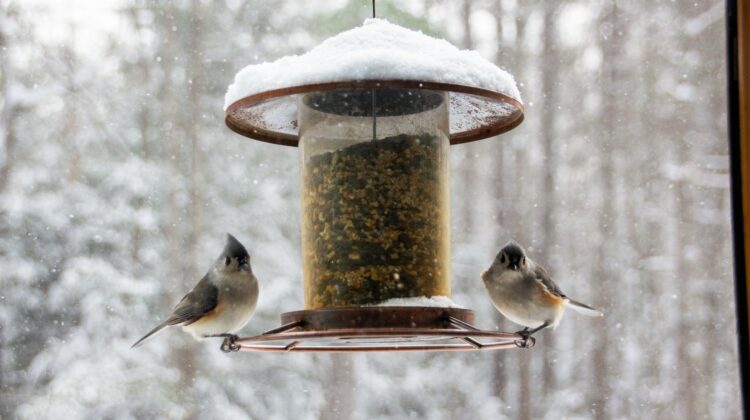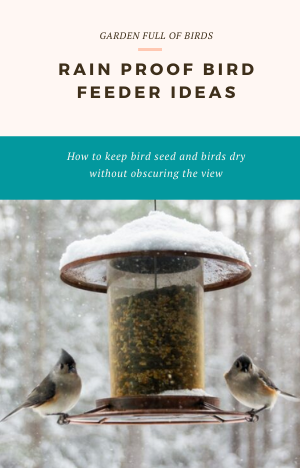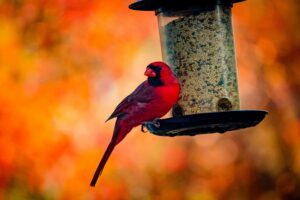
Wet bird seed is an ongoing problem when maintaining any type of bird feeder, particularly those which are open to the elements. In order to keep birds healthy and happy, bird seed offered to them must be kept dry or mould and bacteria will start to grow. This makes the seed less appealing and can cause and transmit various diseases.
Some types of feeders, such as a platform bird feeder with pole, can be made into a rain proof bird feeder with some adjustments. Or you can choose a bird feeder type that is, by design, weatherproof. However, a sudden thaw in winter, an out of season storm or stronger than usual spring downpour can break havoc with the bird feed situation. This is how you prevent and fix it as much as possible.

Problems With Wet Birdseed
Wet seeds are not just unpleasant for humans, they can actually harm your garden visitors by spreading disease. Here is why keeping bird food dry is so important:
- Wet seed will mould and grow bacteria. This can spread diseases to your backyard visitors, and can even be fatal.
- Birds don’t like eating spoiled seed, so they may start avoiding your feeder altogether.
- Wet birdfood stinks and while birds don’t have a good sense of smell, humans do. Also do you know who is attracted by strong smells? mice, rats, racoons and even bears.
- Oily stains on your feeding station can be caused by oily seeds like black sunflower and nyjer seeds. They clump and clog the feeding ports, which makes the feeder less appealing to birds. And they can permanently mark the platform and make it look ugly.
How Do I Make A Waterproof Bird Feeder?
You can start by selecting a position for the feeder that protects it from rain. For example, you can install the feeder under the eaves of a patio, on a secluded porch. While this is not always possible or suitable (many birds won’t come to feeders too close to human buildings) it will help keep your bird seed dry for longer.
If you know the wind and rain usually come from a particular direction, position the feeder so it’s behind the cover of a wall and that will minimise the amount of water the wind brings in. When possible, particularly with hanging platform feeders, you should move them around between seasons. In summer, the birds will appreciate somewhere to eat out of the sun, whereas in winter the feeder should be in a secluded position with as much sunlight as possible.

Alternatively, you can make a little umbrella for your feeder by attaching a squirrel baffle above and close to the feeding tray. This will not only squirrel proof the bird feeder but it will help keep rain and snow out of the food and give the birds some respite from the weather. There are also dedicated rain guards that are very similar to a squirrel baffle, but larger and usually made of glass. They will protect the birds and the food while looking prettier than most squirrel baffles.
Should You Bring Bird Feeders In When It Rains?
It really depends on how much rain and how common an occurrence it is. Birds usually don’t feed during heavy rain, and if we are talking about a spell of bad weather bringing the feeders in is the best way to keep the bird feed dry. However, moving the feeder in and out all the time can cause too much commotion for delicate birds who don’t like large humans near their food.
If the weather is good but unsettled, but water keeps collecting at the bottom of the feeder the solution may be to improve the drainage instead of bringing the feeders in to dry. Bird seed will dry with sun and heat, and as long as water doesn’t accumulate it should be fine, provided you change the food every couple of days. At the end of the day, it’s better to be realistic and buy a feeder that works with your climate. If there is a lot of rain and your feeder doesn’t have good drainage you will need to bring it under cover all the time, possibly disturbing the birds in the process. So just choose a rain proof bird feeder instead.
Rain Proof Bird Feeder Ideas
Rain proof garden feeder come in different styles and weatherproof methods. They don’t need to be unsightly or expensive either!
Choose a waterproof bird feeder that has one of several of the following:
A Roof
Many feeders have a little roof, very much looking like a bird house, and that will keep the bird food dry and clean while looking cute. The only problem is that the roof may obscure the view of the birds themselves eating. However, you will have plenty of chances of seeing them getting to the feeder and fluttering around it, as this sort of safe and secluded feeding station is very appealing to shyer birds.
A Mesh Floor Or Good Drainage Holes
Feeders that have a mesh floor are the best for drainage, and combined with a roof they are a nearly foolproof way of keeping your bird feeders in working order during wet weather. However, they can be annoying if the mesh is not small enough, since feed could fall through! Always make sure to clean the area below the feeding station regularly to avoid accumulating waste there.
If you don’t like mesh bottoms, good drainage holes are also a good option. However, make sure they won’t get clogged easily by wet seeds or it will just make the problem worse! Birds are, in general, messy eaters. So if you give them food that has shells or husks the discarded bits can end up clogging the drainage holes. Always check the status of the drainage when you change the food to prevent issues.
Feeding Ports
A good rain proof feeder is one with ports instead of an open access to the actual food. This way the food reservoir is kept dry and protected, while the birds can still eat as much as they want. If you live in an area where storms, snow or rain are frequent, choose this type of feeder instead of a platform/tray one. The only problem with this type of feeder is that if the birds have access to a platform bird feeder they’ll probably go there because the food is more accessible. So don’t place the two types of feeders near each other if possible.
Keeping Bird Seed Dry: Clean Your Feeders Regularly
Sometimes it’s not water that is directly the problem, but humidity can be. To avoid the feed sprouting, moulding or worse, you should clean the feeders thoroughly at least once every two weeks. If the weather is warm, more frequent cleaning is advised.
A mild soap and water solution can be used to clean all of the crevices, and in the case of rain proof feeders with ports, the ports themselves. You can also use vinegar diluted with four parts of water but you’ll need to rinse it off very well afterwards.
Keep an eye and remove waste and fallen seeds from the ground around the feeder. Birds are messy, some more than others, and while a bit of seed in the ground will attract ground-feeding birds, too much will rot. If it rots, you’ll attract rats instead. So, keep it clean and your backyard visitors will be the happiest.
Bird Seed Storage Tips
If you store bird seed in a shed outdoors, you may discover the whole container has been water damaged before you can even give it to the birds. Use air tight containers placed on a dry and cool location, out of reach of household pets, children and squirrels and mice. Galvanized cans for seed storage are virtually indestructible and rodents won’t be able to chew their way in.
Having a rain proof bird feeder will encourage birds to your garden even when the weather is not at its best, and can provide a lifeline to many species during the colder months. Keeping bird seed dry is key to provide wildlife with suitable food, and if you want to enjoy a garden full of birds it should be one of your main concerns. But it’s not so difficult, and it’s important to remember that the occasional bout of water won’t irreversibly stop birds from visiting your garden. Just do your best and make sure to enjoy the bird watching!
Leave a Reply